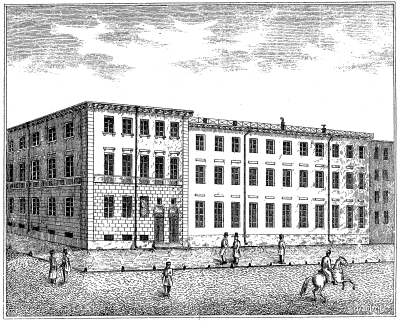New St.Isaac Office Centre
In 1762, Empress Catherine II issued a manifesto inviting settlers to Russia to populate a settlement in the Volga region and a Protestant community of settlers (Sarepta) from Germany was founded near Tsaritsyno.
Proficient craftsmen, the sareptians demonstrated skills in various crafts and turned a small settlement into a large center in the Lower Volga region.
Later sareptians spread across the region and were involved in weaving and tobacco production as well as the founding of candle and soap factories. Moreover, mustard produced here was known throughout the country.
Empress Catherine II gave this three-storey mansion on the corner called the House of Sarepta Society (and which was also known as the Mustard House) to people coming to the capital from this settlement. Two elements coincided—the original mustard-colored exterior of the building and the most famous product from Sarepta: mustard.
The Russian writer, Leskov, mentioned this house in his novel "Iron Will".

From 1810, the sales agent for the Sarepta Company was the Danish merchant Asmus Simonsen. By the mid-19th century, the Asmus Simonsen Company was opened and it became one of the twenty best trading houses in Saint-Petersburg in terms of the volume of exchanges between merchants. Among Simonsen’s partners there were Danes and English men. In 1864, the Trading House of the Sarepta Company participated in the foundation of the first private commercial bank in Russia. Among the founders of this bank was Eliseev, and «Asmus Simonsen and Ko» was represented by F.Mori, the trading agent of the House of Sarepta Society.
Due to successful trading the Sarepta Company was able to rebuild and enlarge their house in St. Petersburg. Under Catherine, this small three-storey house was located on the extension of Malaya Morskaya Street, on the bank of Mastersky Canal which was later filled up with water. Sailors and ship builders lived on this street; it was a part of the Admiralty. In 1841-1842, a new house was built next to the building (a three-storey annex looking towards Konnogvardeysky Lane). The old building was rebuilt in 1849-1850 by the architect, J. Hofer). On the facade there was a black board which read "House of the Sarepta Company".
In 1855 T.Yungblut published a book dedicated to the Protestant Church in St.Petersburg with a lithograph of Sarepta House by R.Berendhof.

Later the building was reconstructed several times and in 1892 the house was sold to the Evangelical Alliance for the Religious and Moral Edification of Protestants.
Shortly after the revolution of 1917, communal and separate apartments were arranged in the house.
The company owner of the New St. Isaac Office Centre appealed to the Culture Committee of St. Petersburg for a permit to reconstruct the marble plaque on the exterior of the building with the inscription reading “The House of Sarepta Society”. The plaque has thus been on the wall of the house since 1840 but was later lost.


